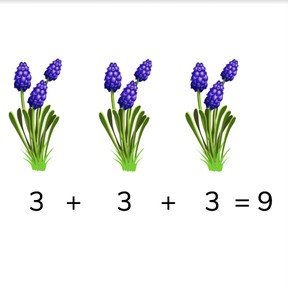



8,000 schools use Gynzy
92,000 teachers use Gynzy
1,600,000 students use Gynzy
General
Students learn to add to 30 using repeating addends.
Common core standard(s)
2.OA.A.1
2.NBT.B.6
Relevance
It is important to be able to add repeating addends so you can simplify adding. If you are able to add repeating numbers you are learning how to multiply. 2+2+2=6 is the same as three times a group of two.
Introduction
Ask students to split the quantities into equal groups. They are asked to circle groups of 3, 4, and 5 on the interactive whiteboard.
How many groups do you make? Are there any students who know what the total is of the groups?
Development
Take 9 objects and split them into equal groups of three. Us this to explain addition with repeating numbers. You can add objects quickly and easily by setting them into equal groups. You will calculate problems that have three or more equal addends. Show them the addition problem 3+3+3=9. You add 3 each time. Using the number line, you can see where you end after every set of three. You count 3, 6, 9.
Repeat this explanation for the next problems. Show them the problem with objects, and show them the steps on the number line. Make sure that the students are counting the objects in groups, and not one by one. Ask students to practice by counting out loud while doing the given exercises. Ask a student to write the answer on the interactive whiteboard. Next, explain how you
calculate these problems if you don't have visual support. You count the groups in your head and imagine the steps on the number line. Ask the students to calculate the problems without visual support. They can choose from three answers and must select the correct answer.
Check that students have understood addition to 30 with repeating addends by asking the following questions:
- What does addition with repeating addends mean?
- Why is this useful?
- Can you demonstrate adding with repeating addends with objects in the classroom?
- What is the total of: 2+2+2+2+2+2?
Guided practice
Students first practice addition with repeating addends by counting objects. Next by calculating an addition problem with visual support, and finally they calculate a total without visual support.
Closing
Divide the class into pairs and give each pair 5 dice. Students, by way of a game, will practice adding repeating addends. The students take turns creating repeating addend addition problems for each other. For example: 4 dice with 5 dots. The addition problem is 5+5+5+5= 20. First practice with the entire class. Explain again why it is useful to be able to add repeating addends. You can add quickly and easily and it helps build skills for multiplication.
Teaching tips
Students who have difficulty adding repeating addends in their head can make use of MAB blocks or other manipulatives, or by drawing the steps on a number line to calculate totals. The students who are comfortable with this, can try to create multiplication problems from the repeating addends. For example they can turn 4+4+4=12 int 3x4=12.
Instruction materials
Dice
Optional: MAB blocks or manipulatives
The online teaching platform for interactive whiteboards and displays in schools
Save time building lessons
Manage the classroom more efficiently
Increase student engagement
Discover more!
About Gynzy
Gynzy is an online teaching platform for interactive whiteboards and displays in schools.
With a focus on elementary education, Gynzy’s Whiteboard, digital tools, and activities make it easy for teachers to save time building lessons, increase student engagement, and make classroom management more efficient.



